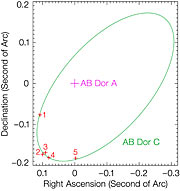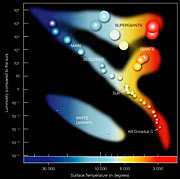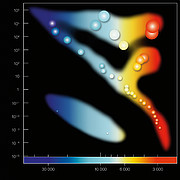Tisková zpráva
Back on Track
New Technique for Observing Faint Companions
19. června 2007
Observing the image of a faint object that lies close to a star is a demanding task as the object is generally hidden in the glare of the star. Characterising this object, by taking spectra, is an even harder challenge. Still, thanks to ingenious scientists and a new ESO imaging spectrograph, this is now feasible, paving the way to an eldorado of many new thrilling discoveries.
These very high contrast observations are fundamental for directly imaging unknown extra-solar planets (i.e. planets orbiting a star other than the Sun), as well as low-mass stars and brown dwarfs, those failed stars that are too small to start burning hydrogen into helium.
Astronomer Niranjan Thatte and his colleagues developed a new method for exactly this purpose. The basis of the concept is relatively simple: while the positions of most of the features associated with the host star and artefacts produced by the telescope and the instrument scale with the wavelength, the location of a faint companion does not. So if the image has an internal reflection of the star masquerading as a planet, this phantom planet will be in one location in the image when looking in red light, and another when looking in blue; a real planet will stay at the same place no matter what colour of light one examines. Therefore, with the combined detection of spectra and position, one can see what is scaling, subtract it, and be left with what is fixed, that is the target dim object. Such observations can be done with specific instruments, called 'integral field spectrographs', such as the SINFONI instrument on ESO's VLT. This technique, termed Spectral Deconvolution (SD), although first proposed in 2002 for space-based applications, has never been applied to obtain spectra of a real object until now.
"We applied our new technique to a puzzling very small stellar companion - about twice the size of Jupiter - known as AB Doradus C and the outcome was surprising, "says Thatte.
Using SINFONI and this new technique, the astronomers could for the first time obtain a spectrum of the object that is free from the light of the brighter companion and that contains all the information necessary for a complete classification.
The new observations lead to a new temperature for the object and change the results that some of the same scientists derived in 2005 (eso0503).
"This is how science progresses," says Laird Close, leader of the science team. "New instruments lead to better techniques and measurements, which often lead to new results, and one must happily change course."
The SINFONI observations were complemented with previous data obtained on ESO's VLT with the NACO instrument, which were stored in the ESO archive.
AB Doradus is a system of 2 pairs of stars (four stars in total: a quadruple system), lying 48 light-years away towards the Doradus constellation (the Swordfish).
AB Doradus A is the young major member of this system and has a faint companion, AB Dor C, just 3 astronomical units (AU) away, or three times the distance between the Earth and the Sun. In our Solar System, this would be within the asteroid belt between the orbits of Mars and Jupiter.
AB Dor C was imaged for the first time, thanks to ESO's VLT, in 2005 (ESO Press Release eso0503). The other members of the system are the pair AB Doradus BaBb (also first imaged in the previous work of 2005) located 133 AU from AB Dor A. While AB Doradus A has a mass about 85 % that of the Sun, AB Doradus C is almost 10 times less massive than AB Doradus A and belongs to the category of cool red dwarfs.
Red dwarfs are extremely interesting because their mass is at the border with that of brown dwarfs. A precise knowledge of these stars is therefore a necessary tile in our understanding of the evolution of stars. If AB Doradus C were only slightly less massive than its 93 Jupiter-mass, it would have failed to become a star, being instead a brown dwarf. As it is, the centre of AB Doradus C is slowly heating up, and in about a billion years its core will become hot enough to begin fusing hydrogen into helium, something a brown dwarf will never do.
"This red dwarf is 100 million times closer to its brighter companion than the whole system is from us and about 100 times less bright. It is thus a perfect example where our very high contrast technique is required," says team member Matthias Tecza.
From the previous observations this unique star seemed to be cooler than expected for an object of such a mass and age. The new, more precise observations show that this is not the case, as the observations are in good agreement with theory, in particular with the models developed by the group of Gilles Chabrier from Lyon, France.
With a temperature of about 3 000 degrees (about half as hot as the Sun) and a luminosity about one thousand times dimmer than the Sun, AB Doradus C lies on the exact track expected for a 75 million year old star with 9% the Sun's mass. AB Doradus C is the only such star (young and cool) with an accurate mass, hence the determination of an accurate temperature is critical for validating these models.
In the future one can thus use these tracks to extrapolate the mass of small young stars, once its temperature and luminosity are precisely determined.
"Small stars are back on the expected track," concludes team member Roberto Abuter.
Poznámky
1. SINFONI is a near-infrared Integral Field Spectrograph (IFS) fed by a MACAO adaptive optics module. An IFS allows the simultaneous recording of two dimensional (angular) plus one dimensional (spectroscopic) information. The end products of integral field spectrographs are cubes of data: two dimensional images extended with a third spectroscopic dimension. So for each of a thousand slightly different colors, a full two-dimensional image is produced. The cube can be cut in slices in order to study the spatial and spectroscopic features of a given region. Movies showing the observations of AB Dor C with this instrument are available at http://www-astro.physics.ox.ac.uk/~thatte/abdorc
2. The advantages of using this newly developed spectral deconvolution (SD) technique with an Integral Field Spectrograph instead of the NACO SDI instrument used in the previous study of this object (ESO 02/05) are that while both techniques can find a faint companion anywhere in the field, this new SD method does not rely on any intrinsic feature of the hidden companion. When considering the spectrum, the continuum can be correctly measured and a high performance is achievable even without a coronagraph. The SD technique simultaneously detects and characterises any faint companion with high accuracy; with NACO SDI any detections had to be followed up by separate observations to take a spectrum. An Integral Field Spectrograph allows for far more efficient use of telescope time. These features make it a precious instrument for the quest of exoplanets.
Další informace
"New Photometry and Spectra of AB Doradus C: An Accurate Mass Determination of a Young Low-Mass Object with Theoretical Evolutionary Tracks", by L.M. Close, N. Thatte, E.L. Nielsen, R. Abuter, F. Clarke, M. Tecza, Astrophysical Journal in press. See http://arxiv.org/abs/astro-ph/0703564
"Very high contrast IFU spectroscopy of AB Doradus C: 9 mag contrast at 0.2" without coronagraph using spectral deconvolution", by N. Thatte, R. Abuter, M. Tecza, E.L. Nielsen, F.J. Clarke, L.M. Close, MNRAS in press. It is available at http://arxiv.org/abs/astro-ph/0703565
Kontakty
Niranjan Thatte
University of Oxford
Oxford, UK
Tel.: +44 1865 27 34 12
Email: thatte@astro.ox.ac.uk
Laird Close
University of Arizona
Arizone, USA
Tel.: +1 520 626 5992
Email: lclose@as.arizona.edu
O zprávě
| Tiskové zpráva č.: | eso0728 |
| Legacy ID: | PR 28/07 |
| Jméno: | AB Doradus, AB Doradus A, AB Doradus C |
| Typ: | Milky Way : Star : Circumstellar Material : Planetary System |
| Facility: | Very Large Telescope |
| Instruments: | NACO, SINFONI |
| Science data: | 2007MNRAS.378.1229T 2007ApJ...665..736C |
Our use of Cookies
We use cookies that are essential for accessing our websites and using our services. We also use cookies to analyse, measure and improve our websites’ performance, to enable content sharing via social media and to display media content hosted on third-party platforms.
ESO Cookies Policy
The European Organisation for Astronomical Research in the Southern Hemisphere (ESO) is the pre-eminent intergovernmental science and technology organisation in astronomy. It carries out an ambitious programme focused on the design, construction and operation of powerful ground-based observing facilities for astronomy.
This Cookies Policy is intended to provide clarity by outlining the cookies used on the ESO public websites, their functions, the options you have for controlling them, and the ways you can contact us for additional details.
What are cookies?
Cookies are small pieces of data stored on your device by websites you visit. They serve various purposes, such as remembering login credentials and preferences and enhance your browsing experience.
Categories of cookies we use
Essential cookies (always active): These cookies are strictly necessary for the proper functioning of our website. Without these cookies, the website cannot operate correctly, and certain services, such as logging in or accessing secure areas, may not be available; because they are essential for the website’s operation, they cannot be disabled.
Functional Cookies: These cookies enhance your browsing experience by enabling additional features and personalization, such as remembering your preferences and settings. While not strictly necessary for the website to function, they improve usability and convenience; these cookies are only placed if you provide your consent.
Analytics cookies: These cookies collect information about how visitors interact with our website, such as which pages are visited most often and how users navigate the site. This data helps us improve website performance, optimize content, and enhance the user experience; these cookies are only placed if you provide your consent. We use the following analytics cookies.
Matomo Cookies:
This website uses Matomo (formerly Piwik), an open source software which enables the statistical analysis of website visits. Matomo uses cookies (text files) which are saved on your computer and which allow us to analyze how you use our website. The website user information generated by the cookies will only be saved on the servers of our IT Department. We use this information to analyze www.eso.org visits and to prepare reports on website activities. These data will not be disclosed to third parties.
On behalf of ESO, Matomo will use this information for the purpose of evaluating your use of the website, compiling reports on website activity and providing other services relating to website activity and internet usage.
Matomo cookies settings:
Additional Third-party cookies on ESO websites: some of our pages display content from external providers, e.g. YouTube.
Such third-party services are outside of ESO control and may, at any time, change their terms of service, use of cookies, etc.
YouTube: Some videos on the ESO website are embedded from ESO’s official YouTube channel. We have enabled YouTube’s privacy-enhanced mode, meaning that no cookies are set unless the user actively clicks on the video to play it. Additionally, in this mode, YouTube does not store any personally identifiable cookie data for embedded video playbacks. For more details, please refer to YouTube’s embedding videos information page.
Cookies can also be classified based on the following elements.
Regarding the domain, there are:
- First-party cookies, set by the website you are currently visiting. They are stored by the same domain that you are browsing and are used to enhance your experience on that site;
- Third-party cookies, set by a domain other than the one you are currently visiting.
As for their duration, cookies can be:
- Browser-session cookies, which are deleted when the user closes the browser;
- Stored cookies, which stay on the user's device for a predetermined period of time.
How to manage cookies
Cookie settings: You can modify your cookie choices for the ESO webpages at any time by clicking on the link Cookie settings at the bottom of any page.
In your browser: If you wish to delete cookies or instruct your browser to delete or block cookies by default, please visit the help pages of your browser:
Please be aware that if you delete or decline cookies, certain functionalities of our website may be not be available and your browsing experience may be affected.
You can set most browsers to prevent any cookies being placed on your device, but you may then have to manually adjust some preferences every time you visit a site/page. And some services and functionalities may not work properly at all (e.g. profile logging-in, shop check out).
Updates to the ESO Cookies Policy
The ESO Cookies Policy may be subject to future updates, which will be made available on this page.
Additional information
For any queries related to cookies, please contact: pdprATesoDOTorg.
As ESO public webpages are managed by our Department of Communication, your questions will be dealt with the support of the said Department.




